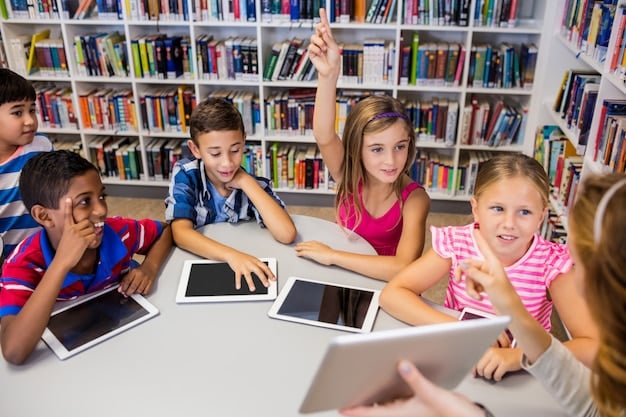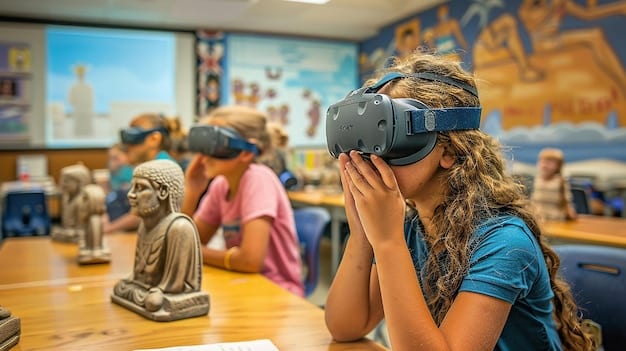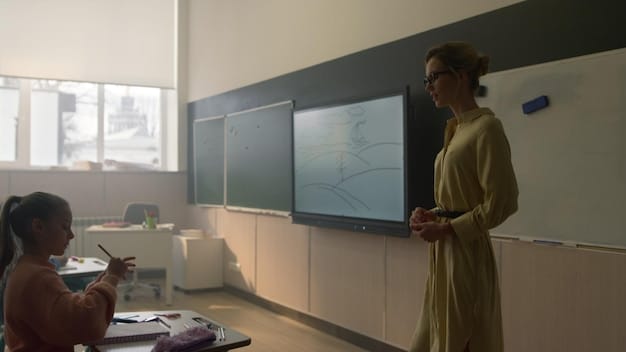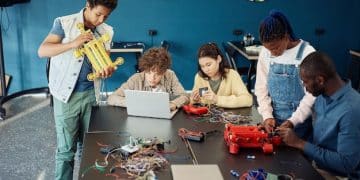Latest Trends in Educational Technology: Transforming Classrooms

The Latest Trends in Educational Technology: Transforming the Classroom Experience include personalized learning platforms, immersive technologies like virtual reality, artificial intelligence-driven educational tools, and adaptive assessments, all designed to create more engaging, efficient, and equitable learning environments.
Step into the future of learning! The way we teach and learn is undergoing a massive shift, driven by exciting new technologies. Discover how these innovations are reshaping classrooms and boosting student engagement.
The Rise of Personalized Learning Platforms
Personalized learning is no longer a futuristic concept but a present-day reality. Educational technology is enabling educators to tailor learning experiences to meet the unique needs of each student. This approach is transforming how classrooms operate and improving student outcomes.
Adaptive Learning Systems
Adaptive learning systems analyze student performance in real-time, adjusting the difficulty and content of lessons to match their skill level. This ensures that students are neither bored nor overwhelmed, promoting a more effective learning process.
Customized Content Delivery
Teachers can now use platforms to create and deliver customized content that aligns with individual learning styles and preferences. Tools like interactive videos, simulations, and gamified quizzes keep students engaged and motivated.
- Enhanced Student Engagement: Personalized content keeps students more interested and active in their learning.
- Improved Learning Outcomes: Tailored instruction leads to better understanding and retention of information.
- Data-Driven Insights: Educators gain valuable insights into student progress, allowing for targeted interventions.

Personalized learning platforms are revolutionizing education by offering tailored learning experiences that cater to individual student needs. This shift promotes greater engagement, improved academic outcomes, and a more dynamic classroom environment.
Immersive Technologies: VR and AR in Education
Virtual Reality (VR) and Augmented Reality (AR) are creating unprecedented opportunities for immersive learning experiences. These technologies transport students to new worlds and make abstract concepts tangible, transforming the way they interact with educational content.
Virtual Field Trips
VR allows students to take virtual field trips to historical sites, museums, and even outer space. These experiences provide a sense of presence and immersion that traditional textbooks cannot replicate, enhancing both engagement and knowledge retention.
Interactive Simulations
AR overlays digital information onto the real world, allowing students to interact with complex systems and concepts in a hands-on manner. For example, students can dissect a virtual frog or explore the human anatomy using AR simulations.
- Enhanced Engagement: VR and AR turn learning into an adventure, capturing students’ attention and sparking curiosity.
- Deeper Understanding: Immersive experiences make abstract concepts concrete, fostering a deeper understanding.
- Accessibility: VR and AR can provide access to educational experiences that might otherwise be unavailable due to geographical or financial constraints.
Immersive technologies like VR and AR are enhancing educational experiences by providing interactive simulations and virtual field trips. These innovations make learning more engaging, accessible, and effective for students of all ages.
AI-Driven Educational Tools
Artificial Intelligence (AI) is rapidly transforming education by offering tools that automate administrative tasks, personalize learning, and provide intelligent tutoring. AI is enhancing both the efficiency and effectiveness of the educational process.
Intelligent Tutoring Systems
AI-powered tutoring systems provide personalized feedback and support to students, adapting to their individual learning styles and pace. These systems can identify knowledge gaps and offer targeted interventions, supplementing traditional teaching methods.
Automated Assessment and Grading
AI tools can automate the assessment and grading of assignments, freeing up teachers’ time to focus on instruction and student interaction. These tools use natural language processing to evaluate written work and provide detailed feedback.
- Personalized Learning: AI adapts to individual learning styles, providing tailored instruction and support.
- Efficiency: AI automates time-consuming tasks, allowing educators to focus on student engagement.
- Data-Driven Insights: AI provides valuable data on student performance, informing instructional decisions.

AI-driven educational tools are streamlining administrative tasks, personalizing learning experiences, and providing intelligent tutoring. These advancements are enhancing the efficiency and effectiveness of education, leading to improved student outcomes.
The Shift to Adaptive Assessments
Traditional standardized tests are being replaced by adaptive assessments that measure student progress in a more nuanced and individualized way. These assessments provide real-time feedback and insights, enabling teachers to adjust their instruction accordingly.
Formative Assessment Tools
Formative assessment tools provide ongoing feedback to students and teachers, helping to identify areas where additional support is needed. These tools use techniques like quizzes, polls, and interactive activities to gauge student understanding.
Personalized Feedback
Adaptive assessments provide personalized feedback to students, highlighting their strengths and areas for improvement. This feedback helps students understand their learning progress and motivates them to achieve their goals.
- Real-Time Feedback: Adaptive assessments provide immediate feedback, allowing for timely interventions.
- Personalized Learning: Assessments adapt to individual skill levels, ensuring an accurate measure of knowledge.
- Data-Driven Insights: Teachers gain valuable data on student progress, informing instructional strategies.
Adaptive assessments are transforming education by providing real-time feedback, personalized insights, and data-driven decision-making. This shift enhances the effectiveness of instruction and improves student outcomes.
Gamification in Education
Gamification involves integrating game-like elements into the learning process to enhance engagement and motivation. By incorporating features like points, badges, leaderboards, and challenges, educators can make learning more fun and rewarding.
Interactive Learning Games
Interactive learning games provide students with opportunities to apply their knowledge in a fun and engaging manner. These games can cover a wide range of subjects and skills, from math and science to language arts and history.
Reward Systems
Reward systems provide students with incentives to achieve learning goals. These systems can include virtual badges, certificates, or even real-world prizes, motivating students to stay engaged and excel in their studies.
- Increased Engagement: Gamification makes learning more fun and engaging, capturing students’ attention.
- Motivation: Reward systems provide incentives to achieve learning goals, motivating students to excel.
- Improved Learning Outcomes: Gamified learning experiences enhance knowledge retention and application.
Gamification is revolutionizing education by making learning more engaging, rewarding, and effective. By integrating game-like elements into the learning process, educators can capture students’ attention and motivate them to achieve their full potential.
The Role of Cloud Computing in Education
Cloud computing is transforming education by providing access to a wide range of resources and tools from anywhere with an internet connection. This technology enables greater collaboration, flexibility, and accessibility in the learning process.
Collaborative Learning Platforms
Cloud-based platforms facilitate collaborative learning by allowing students to work together on projects, share resources, and communicate in real-time. These platforms promote teamwork, communication skills, and a sense of community.
Accessibility and Flexibility
Cloud computing provides students with access to educational resources and tools from any device, at any time. This flexibility is particularly beneficial for students with disabilities or those who live in remote areas.
- Collaboration: Cloud platforms facilitate teamwork and communication, enhancing collaborative learning experiences.
- Accessibility: Cloud computing provides access to educational resources from anywhere, at any time.
- Cost-Effective: Cloud solutions reduce the need for expensive hardware and software, making education more affordable.
Cloud computing is transforming education by providing access to collaborative platforms, enhancing accessibility, and promoting cost-effectiveness. This technology is empowering educators and students alike to achieve their full potential.
| Key Trend | Brief Description |
|---|---|
| 🎯 Personalized Learning | Tailoring education to meet individual student needs and learning styles. |
| 🎮 Gamification | Using game-like elements to enhance engagement and motivation in learning. |
| 🤖 AI in Education | Implementing artificial intelligence for personalized tutoring and automated tasks. |
| ☁️ Cloud Computing | Leveraging cloud-based platforms for collaborative and accessible learning. |
Frequently Asked Questions
▼
Personalized learning tailors educational content and methods to fit each student’s unique needs, learning style, and pace. It aims to enhance engagement and improve learning outcomes by making education more relevant and accessible.
▼
AI enhances education by providing personalized tutoring, automating assessments, and offering data-driven insights. These AI tools free up teachers’ time and provide students with customized support, leading to more effective learning experiences.
▼
Gamification makes learning more engaging and fun by incorporating game-like elements such as points, badges, and leaderboards. This approach increases student motivation, improves knowledge retention, and enhances overall learning outcomes.
▼
VR and AR transform learning by creating immersive and interactive experiences that make abstract concepts tangible. Virtual field trips and interactive simulations enhance engagement and understanding, providing students with new ways to explore and learn.
▼
Cloud computing provides access to educational resources and tools from anywhere with an internet connection, promoting collaboration, flexibility, and accessibility. Cloud-based platforms facilitate teamwork and make education more cost-effective and convenient.
Conclusion
The integration of educational technology is revolutionizing the classroom experience, offering personalized, engaging, and effective learning opportunities. By embracing these advancements, educators can prepare students for success in the 21st century and beyond, fostering a new generation of innovative thinkers and problem-solvers.





